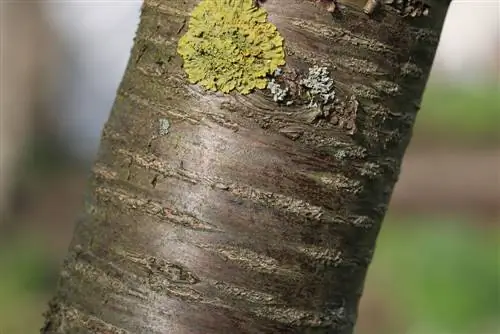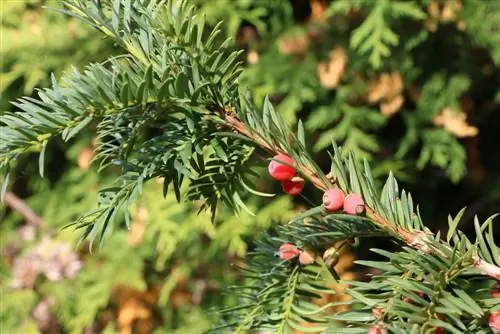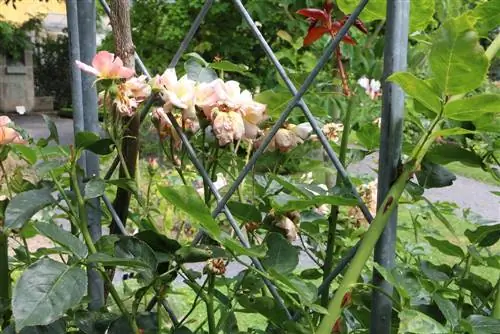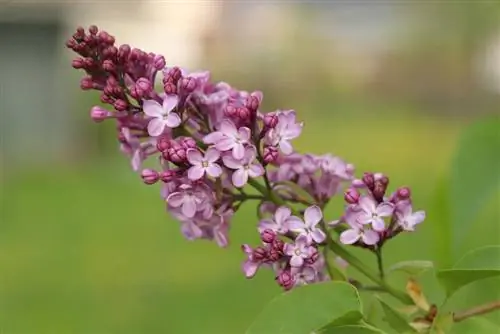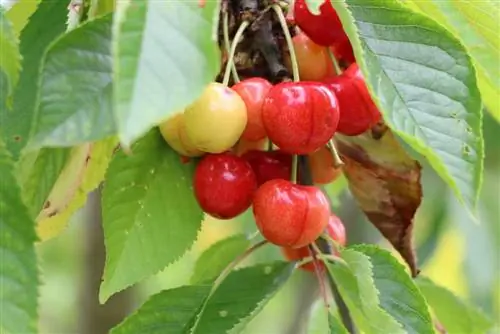- Author admin [email protected].
- Public 2023-12-17 03:39.
- Last modified 2025-06-01 06:48.
Even with old cherry trees that are twenty or more years old, this is rarely a problem. On the contrary: a crown that is too dense reduces yields and promotes fungal infections. However, there are a few things you should keep in mind.
When is the right time to cut?
As I said, there is no official age limit for rejuvenation. But a cherry tree that is a little old requires that you be careful when cutting it. Interventions that are too sudden damage it and reduce crop yields. Nevertheless, you should use the saw every year. However, when exactly should be cut is controversial. Many fruit trees require thorough winter pruning. This is even possible with the cherry tree. Although winter rejuvenation is the most common way of pruning fruit, it has some disadvantages compared to summer pruning.
Winter pruning causes so-called water shoots to grow on the crown of fruit trees: wild shoots that sprout steeply upwards. They are useless to the tree. They take the light away from the cherries. Sweet cherries in particular benefit more from summer pruning after the harvest season. Sour cherries a little later. Summer wound healing occurs very quickly. The summer cut can also complement the winter cut. The wild shoots can then simply be torn off (“summer tear”). Act before the shoots become woody! Shoot growth can be stopped even more effectively in summer: shorten branches and shoots until the next fruit sets. The cherries will benefit from more light later.
Tip:
The most unfavorable time for pruning cherry trees is autumn. The wounds heal poorly. Rainfall levels are high and the risk of tree diseases is increased.
Preparation and small economy of cherry tree pruning
What do you expect? Yes, the pruning behavior should largely depend on how the cherry tree will develop next year, in the next few years. If you cut back heavily, you can expect strong growth the following year. However, fewer flower buds are then formed - their fruit yield decreases quantitatively. But the cherries will be bigger. Those who hold back very much accept weaker growth. In return, more flower buds will grow. The harvest will be rich. However, the cherries will be quite small. Flower and fruit set decline most significantly if no pruning is carried out.
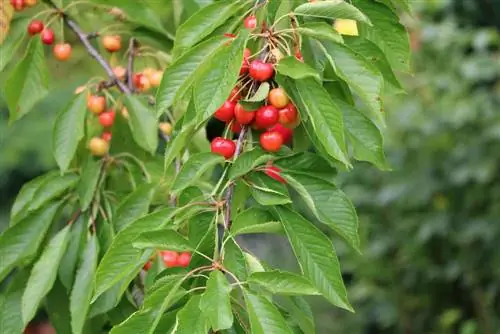
Aesthetic preferences and sensible interventions play an equal role in the cut. Look closely at the tree and imagine an exact image of what you want the cherry to look like afterwards. However, it should not be cut arbitrarily.
The main goal is to reduce the overall size of the crown. In addition, leaves and fruit-bearing shoots should be approximately in balance. Some side branches grow into the interior of the tree. They will be removed first. Drooping branches should be shortened significantly. Basically, everything that shoots up steeply should be separated. And sometimes even very strong branches have to give way when the crown becomes thinner. However, you should spare some parts of the plant: the bouquet shoots. Because they will give you the most cherries at the next harvest. You will recognize it as a shorter side shoot, arranged like a whorl.
These are the basic rules. But what is needed? Just a saw and arm strength? In order to rejuvenate your cherry tree professionally, you need to get the right tools and aids:
- a high-quality pruning saw (hacksaw) and pruning shears,
- stable ladder,
- a hippe (small sharp tree knife) or bark scraper,
- Disinfectants and
- Wound protection products for plants
Sawing off thicker branches: This is how you do it
All cutting surfaces used should be disinfected before work. Otherwise, infectious diseases on the tree are possible. Now the real work begins:
- Remove all branches from the selected branch with the pruning shears. These could cause problems later, make access more difficult or drag the gardener along on the ladder.
- Then you decide where the cut will be made. It would be best to shorten shoots just above a bud so that the cut surface faces downwards.
- Only shorten the buds that point towards the edge of the crown. But the choice is often limited. So you won't be able to cut the branches back to a specific bud.
- You then start either above a favorable branch or in front of an astring. You can recognize the branch ring as a slightly thickened attachment point on a branch. Under no circumstances should you cut it off! It contains reserves that later facilitate wound healing and growth.
- At best there is a distance of about 20 centimeters between it and the interface. Try to prevent the branch from breaking downwards. In many cases it also tears off the trunk bark and wood.
- The large wounds that result from this heal very poorly. This works if you start from below. It should be sawn from the bottom to the middle. Then start at the top - slightly offset towards the tip of the branch.
- Saw either all the way through or until the branch can be broken off without difficulty. Saw off the remaining stub. For the edges of the wound, use the hippe. The small tree knife is ideal for smoothing the edges.
- Last but not least, the sawing area should be coated with wound protection product from a specialist retailer. This applies to all wounds larger than a euro coin.
What you need to know about cherry tree pruning
Having a cherry tree in the garden has numerous advantages: having fresh fruit right at home, being able to enjoy a large source of shade in the summer and last but not least the look through which the cherry tree enhances the garden at home enriched. But a cherry tree can also become a problem. For example, if it is an old cherry tree and as a home and garden owner you ask yourself whether the decades-old tree, which may already protrude too much onto the neighboring property, can be cut without causing permanent damage.
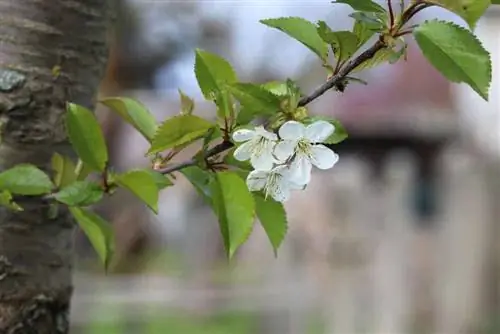
Pruning every year makes sense, even for old cherry trees. In contrast to many other fruit trees, which are best pruned during the vegetation break (winter pruning), cherry trees tolerate summer pruning better. You will recover more quickly and thank you for the next harvest, depending on your cutting behavior, with bud growth or thicker cherries. Especially on old cherry trees, branches must be properly cut off. Keep the wounds small and take good care of them.
The result:
A productive and attractive tree.
The procedure should be as follows: The crown is reduced in size and thinned out; older branches in particular must be removed, while young branches should remain. Often, laypeople in particular are a little too hesitant when it comes to old cherry trees. If there are still a lot of shoots on the tree and the garden owner adheres to the rules described here, basically nothing can go wrong and a few more branches can be cut off.
Also read: Cutting sweet cherries.

